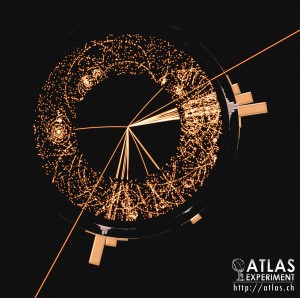Large Hadron Collider Begins!
The first proton-proton collisions have begun at the Large Hadron Collider (LHC) located at the CERN laboratory in Geneva, Switzerland. On March 30th, 2010 the LHC achieved a new world record energy by colliding two beams at a center-of-mass energy of 7 TeV, signifying the beginning of the “First Physics” run at the LHC. Boston University has been deeply involved in both of the two large general-purpose experiments, ATLAS and CMS, and the particle theory group has been gearing up to study the results from the LHC collisions.
ATLAS
Boston University has played many important roles in the design and construction of the ATLAS muon system at the LHC. Under Professor Steve Ahlen’s direction, BU and Harvard set up a chamber construction facility for the Boston Muon Consortium and designed the Monitored Drift Tube (MDT) muon chamber for the Endcap region of Atlas. Ultimately, approximately 500 Endcap MDT chambers were produced world-wide based on this design, including almost 100 by the Boston Muon Consortium. Ahlen, along with students and scientists Jeremy Love, Marta Lewandowska, Alex Marin, Nigel Nation and Yan Zhen were members of the US team to installation and commission this important part of the Atlas detector at CERN.
The BU Group continued their long-time leadership in ATLAS software and computing. Research Professors Jim Shank and Saul Youssef have made important contributions to commissioning of the ATLAS computing systems, using the grid to distribute data and analysis jobs, and in establishing the Tier 2 center at BU. The BU Tier 2 demonstrated its readiness with successful participation in recent worldwide exercises of ATLAS computing. Shank is the Computing Coordinator for ATLAS. Shank, Youssef, Professor John Butler, Robert Harrington and Love have also made numerous contributions to software required for the muon system hardware described above. Butler and Love have published a study of the discovery potential with early data in the dimuon final state, taking a technicolor model as the source of new dimuon resonances.
CMS
At the center of the CMS detector (Compact Muon Solenoid) is the 1000 ton hadron calorimeter whose 10,000 channels of electronics was in large part designed and built at Boston University. Members of the BU CMS team have also helped design the two hadronic forward calorimeters which are positioned at either end of the CMS detector, to pick up the myriad particles coming out of the collision region at shallow angles relative to the beam line. Boston University scientists and engineers have also been instrumental in the design and commissioning of the CMS trigger system. The trigger is responsible for reducing the input data to a rate that can be sustained for writing to permanent storage media.
The BU CMS team has also been actively involved in analyzing the new 7-TeV collision data. A number of physics analyses are underway with publications expected in the next year or two. These analyses include searches for dijet resonances, long-lived gluinos, exotic WZ resonances and new heavy gauge bosons. Boston University researchers currently involved in CMS include Professors Tulika Bose, Jim Rohlf and Larry Sulak, Research Professor Arno Heister, research scientists Edgar Carrera and Dragoslav Lazic, and graduate students Cory Fantasia, Phil Lawson, David Sperka, and Jason St. John. Undergraduates Elim Cheung, Mike Dimitriyev, Michael Hedges and Ashley Rubinstein have also contributed to this effort.
Continue reading: Lepton Dipole Moments
Return to Research
 Physics | Annual Report 2010
Physics | Annual Report 2010 